Posts Categorized / Mothkeeping
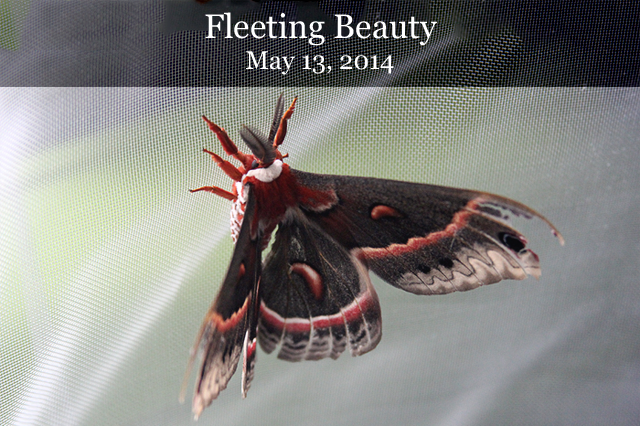
Giant silk moths are beautiful and impressive. They are also short-lived and fragile. Cedric emerged only a few days ago and unfurled his wings without a hitch, but I am already watching him begin to fade. This morning I found he had managed to tear his wingtips overnight. It’s mostly aesthetic damage – he’s demonstrated he can still fly – yet it is an irreversible change that signals a coming end. In the past six months, I have been faced with the shocking permanence of sudden death; it is bittersweet that I know Cedric’s last day is coming, that I can prepare but that I must lose him so soon. I have yet to see how it will change my interaction with the other two moths. Some ideas occur to me already.
In some respects, I learned to be a bit of a documentarian from my dad: I’d rather have a picture or record of something meaningful than not, even if the photo doesn’t turn out very well. It is a way of preserving the past that is honest and tangible. Photos aren’t skewed by time as memories are. Someday I may be as far removed in years from this experience as I am from my own birth right now. This is why I have taken more pictures of Cedric despite his injury and why I have carefully considered how to document the remaining moths. Perhaps my thoughts on the matter will be helpful to others doing this in the future, too.
Immediately after eclosure was the best time for pictures with Cedric. I captured his first moment out and kept snapping pics at intervals throughout the time it took for his wings to expand. He was very still during this process, aside from adjusting his posture now and then, and remained still into the evening. It wasn’t possible to get a full view of his wings until later, though. I also found that getting him to cling to a piece of paper allowed me to gently manipulate him to take photos from different angles. The pictures of us touching are cute, but it worked best when I let Cedric to decide to climb on me at his own pace. (It may go without saying, but never touch moth wings. Human skin scrapes scales off even with light contact.) I may have more to say on the matter after all three moths have come and gone.
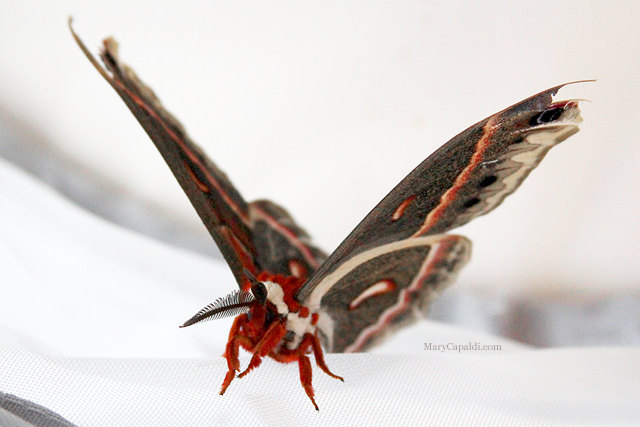
Still lovely, even with wing damage.
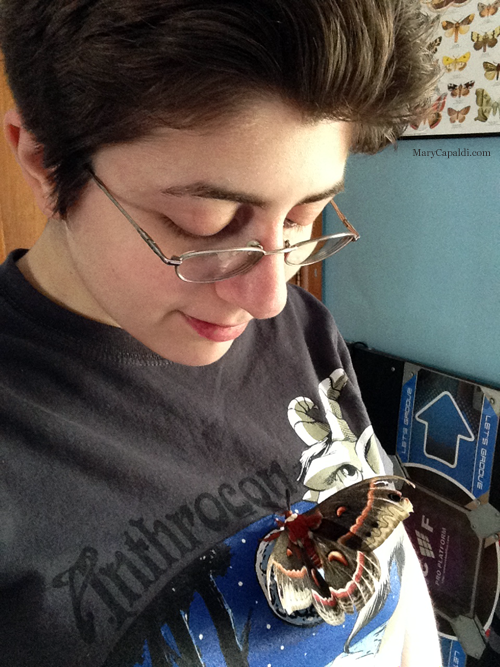
Oh, the places you’ll sit.
Meanwhile, the luna moth surprised me today by emerging midafternoon! I hadn’t been expecting it for at least another day. Like Cedric, the luna was a little sneak and waited until I was out of the room to make its escape. I came back to find the pupa shell with an obvious hole in it and the moth nowhere in the container. It had climbed over the side and suspended itself from the edge of one of the paper towels I’d lined the box with. Turns out I was right to doubt my assessment of the moth’s sex, though – the luna is a girl! I’ve named her Terry since her male name would’ve been Terrence (in reference to a joke my dad made last year about the moths).
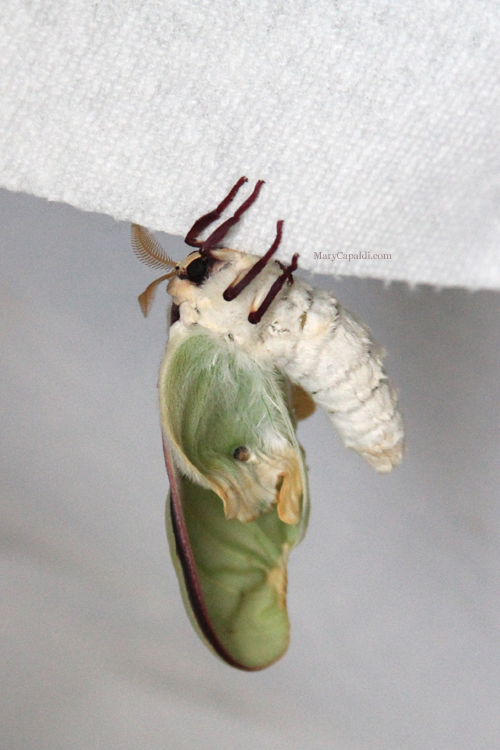
As I found her.
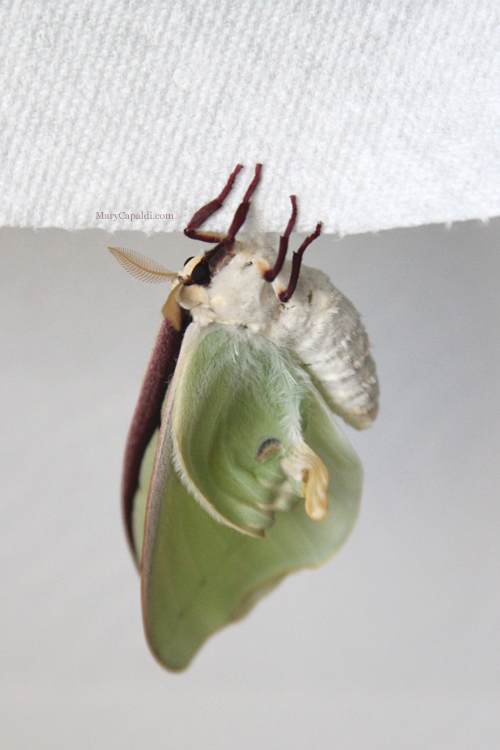
Working on those wings!
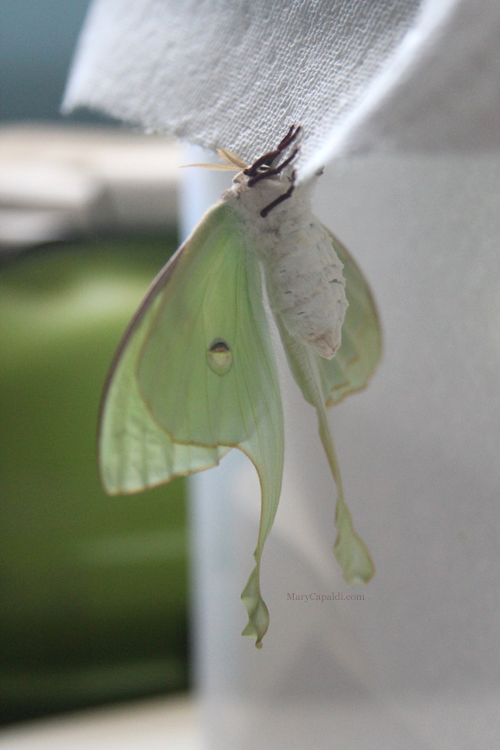
She might actually be a fairy.
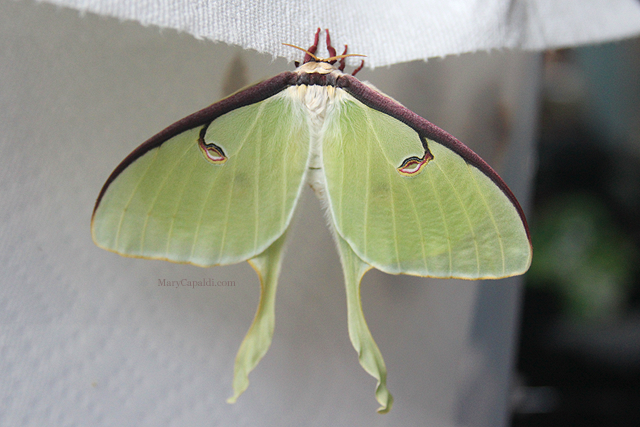
Her markings aren’t perfectly symmetrical, but she’s no less lovely for it.
I was not expecting a lady and so had no setup on hand to allow her to attract a mate. One was thrown together quickly, though there aren’t any guarantees a boy will come by. The immediate area I live in is fairly developed; I have never seen a wild luna here despite them being native to the state. If she doesn’t mate within a few nights, she’ll lay unfertilized eggs.
It’s difficult to tell since it’s only her first day, but so far Terry has demonstrated a quieter temperament and is less flighty than Cedric. She sat on my hand without fidgeting for a while after her wings were settled. I look forward to the next few days with her and will, of course, take many more pictures. Perhaps the final cecropia will emerge just as she begins to fade.
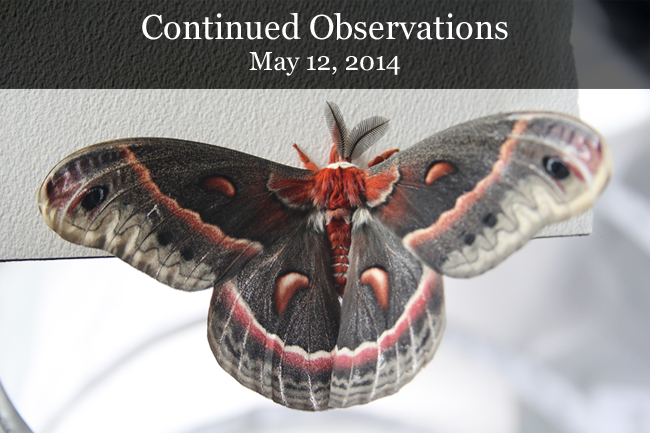
I did my Moth Series 1 paintings before I’d had many chances to observe and interact with live moths. As such, they are impressions constructed from reference pictures and the odd video clip; they represent concepts of the creatures I depicted rather than being entirely accurate scientific illustrations. Now, I have not only seen live Atlas moths resting on the walls of the Academy of Natural Sciences Butterflies! exhibit, but have actually raised a moth of my own and held it. I’ve seen Cedric walk and fly and move in unexpected ways. I have to wonder how those pieces would be different if I painted them now – and how Series 2 will stand apart as I draw from a much-widened impression for the paintings to come.
Yesterday I mentioned that Cedric, like most large moths, must vibrate his wings in order to get them warm enough to fly. He also does this interesting little march just before taking off or when he’s landed but intends to get airborne again shortly. It’s jaunty and brisk, almost robotic. I may try to get a video next time he’s active.
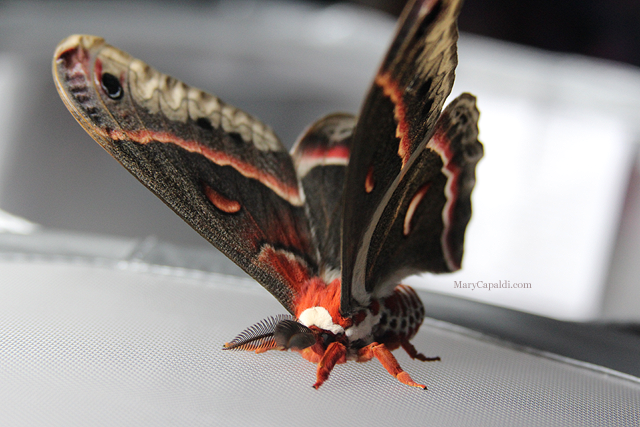
He almost looks as if he’s bowing.

Another spread view of his wings.
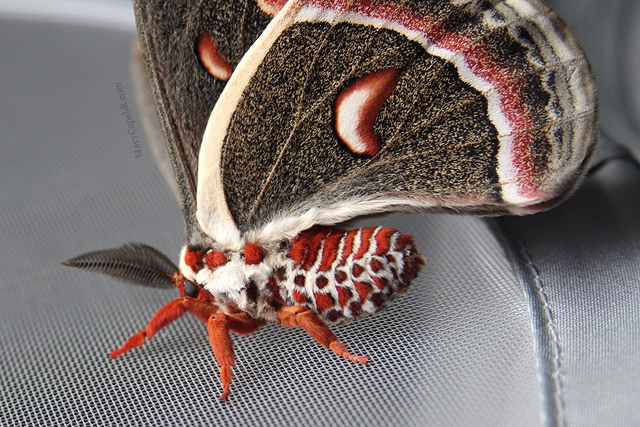
A close up of that fluffy body!
I have kept an eye on the remaining pupae and was surprised today to notice that the luna’s wings can be made out in their entirety through the amber shell. Previously, a little green was visible, but now the eye marking and dark upper edge of the forewings can be seen too. It’s tricky to photograph:

See the black swooping lines just below the antennae?
The other cecropia doesn’t look ready to eclose just yet but is still alive.
Based on my experiences so far with Cedric, I’ve had some thoughts about how to better prepare if I decide to repeat this experience for the 2015 flight. The mesh basket isn’t too small for one moth, but I’d like to be able to give them more space. I’d also want to raise a larger population to increase the chance of getting a distribution of both sexes so at least some of them will be able to mate. To that end, I might just stick to one species. Either way, I’d definitely be more willing to release unmated males in the future; this year I am hanging onto them because I intend to keep the preserved specimens for reference once they’ve passed. It has been an interesting experience, and I may well take the opportunity to try again next year with a species I wasn’t able to get ahold of this time: Polyphemus. We shall see!
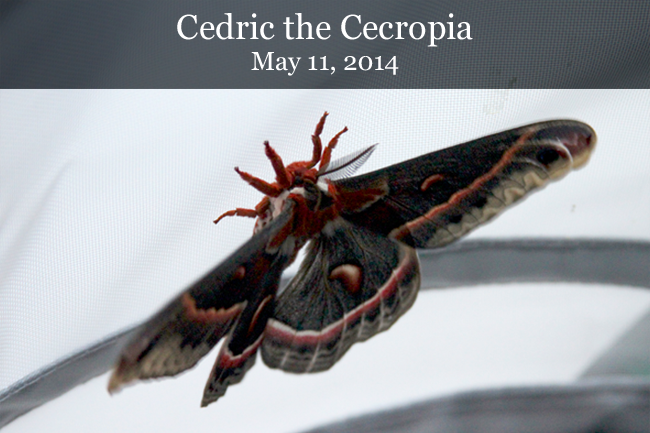
Upon waking this morning, I found Cedric hanging upside down from the top of the mesh basket. This proved to be a theme for the day. He fluttered around a little as I carefully lifted the lid to take some more pictures, but it wasn’t long before he climbed aboard my arm again and decided he really wanted to hang from the side of my hand. I’m not sure if he was attracted to my warmth or if my skin provided a more secure surface than the mesh basket. Regardless, he stayed there for over half an hour until I needed to do tasks that required both hands.
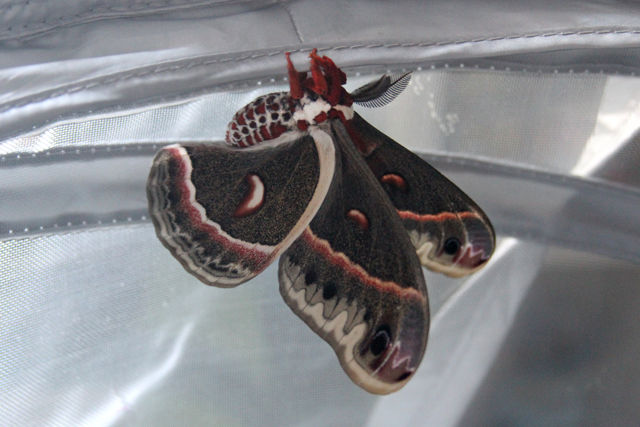
Hanging from the top edge of the basket.
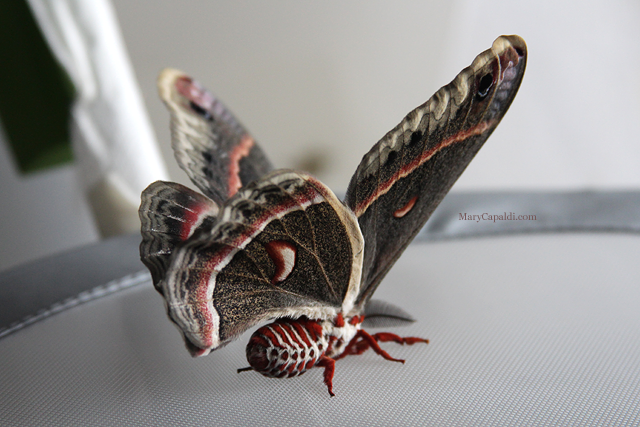
A rear view of his beautiful wings.
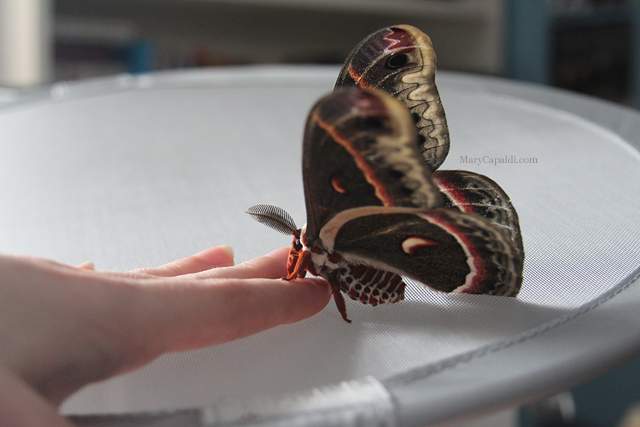
As big as he looks for a moth, I marvel at how small a creature he is.
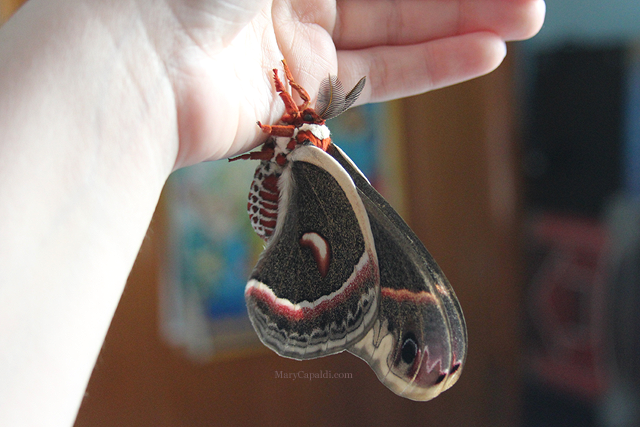
And there he stayed for a while.
Unlike my cartoon bugs, the majority of Cedric’s expressiveness comes from his wings and legs. He flares his wings and moves them in a particular way when he’s agitated. Before flying, he has to vibrate his wings rapidly to warm them up. He flails his front legs when something is too close to him, or when he’s trying to get a good grip, or if he otherwise seems distressed. I even saw him rub his front legs across his antennae several times each today – I’m not an expert, but this behavior appeared very similar to when I was once observing house centipedes and saw them clean their antennae. I suspect he was doing the same, as the action dislodged tiny bits of dust.
Getting close looks at Cedric has helped me better envision how my bug characters would be structured in a 3D space. His face and eye placement in particular is very helpful. The many pictures I’ve taken of his wings in various positions at different angles is also going to help a lot for my own moths and butterflies when I begin telling longer, more elaborate stories with them.








 Posted by Mary in
Posted by Mary in 









